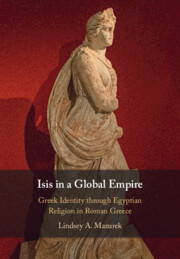Book contents
- Isis in a Global Empire
- Isis in a Global Empire
- Copyright page
- Contents
- Illustrations
- Acknowledgments
- Chapter One Egyptian Religion and the Problem of Greekness
- Chapter Two Building Groupness
- Chapter Three Deterritorializing Theology?
- Chapter Four Self-understanding
- Chapter Five Self-fashioning
- Chapter Six Self-location
- Chapter Seven Conclusion
- Notes
- Bibliography
- Index
Chapter Four - Self-understanding
Visualizing Isis in Stone
Published online by Cambridge University Press: 06 February 2022
- Isis in a Global Empire
- Isis in a Global Empire
- Copyright page
- Contents
- Illustrations
- Acknowledgments
- Chapter One Egyptian Religion and the Problem of Greekness
- Chapter Two Building Groupness
- Chapter Three Deterritorializing Theology?
- Chapter Four Self-understanding
- Chapter Five Self-fashioning
- Chapter Six Self-location
- Chapter Seven Conclusion
- Notes
- Bibliography
- Index
Summary
This chapter considers the role that ideal sculptures in sanctuary settings play in the process of self-understanding: the beliefs and ideologies that give shape to a group and also inform how outsiders perceive the group. Using the Sarapeum of Thessaloniki as a case study, this chapter defines the Greek sculptural types and materials used most commonly to depict Isis and Sarapis in Greece, and explores their relationships with Greek sculptures that were often displayed alongside these images.
- Type
- Chapter
- Information
- Isis in a Global EmpireGreek Identity through Egyptian Religion in Roman Greece, pp. 88 - 119Publisher: Cambridge University PressPrint publication year: 2022

